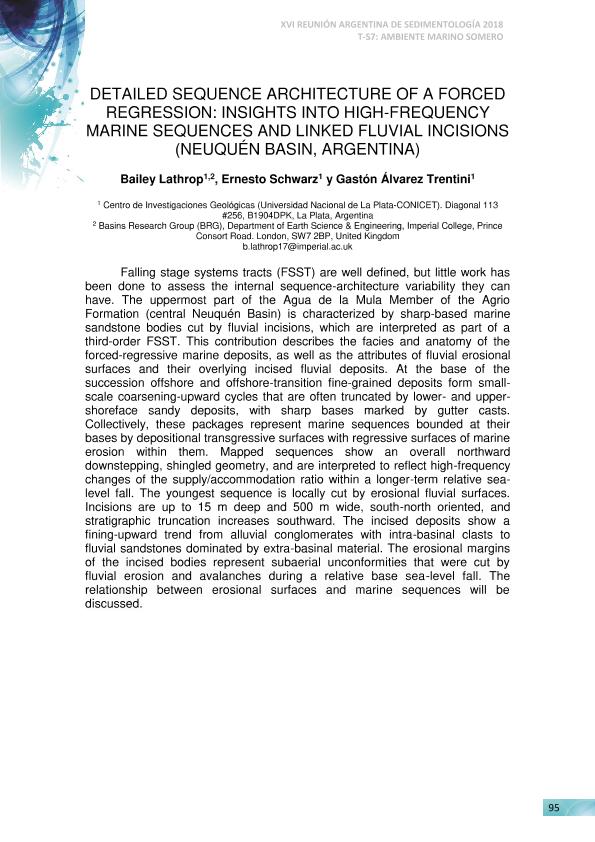Evento
Detailed sequence architecture of a forced regression: Insights into high-frequency marine sequences and linked fluvial incisions (Neuquén basin, Argentina)
Colaboradores:
Báez, Alejandro David ; Gómez, Ricardo
; Gómez, Ricardo
 ; Gómez, Ricardo
; Gómez, Ricardo
Tipo del evento:
Reunión
Nombre del evento:
XVI Reunión Argentina de Sedimentología
Fecha del evento:
26/11/2018
Institución Organizadora:
Asociación Argentina de Sedimentologia;
Universidad Nacional de Río Negro;
Título del Libro:
Libro de Resúmenes de la XVI Reunión Argentina de Sedimentología: Sedimentología Sin Frontera
Editorial:
Asociación Argentina de Sedimentología
Idioma:
Español
Clasificación temática:
Resumen
Falling stage systems tracts (FSST) are well defined, but little work has been done to assess the internal sequence-architecture variability they can have. The uppermost part of the Agua de la Mula Member of the Agrio Formation (central Neuquén Basin) is characterized by sharp-based marine sandstone bodies cut by fluvial incisions, which are interpreted as part of a third-order FSST. This contribution describes the facies and anatomy of the forced-regressive marine deposits, as well as the attributes of fluvial erosional surfaces and their overlying incised fluvial deposits. At the base of the succession offshore and offshore-transition fine-grained deposits form smallscale coarsening-upward cycles that are often truncated by lower- and uppershoreface sandy deposits, with sharp bases marked by gutter casts. Collectively, these packages represent marine sequences bounded at their bases by depositional transgressive surfaces with regressive surfaces of marine erosion within them. Mapped sequences show an overall northward downstepping, shingled geometry, and are interpreted to reflect high-frequency changes of the supply/accommodation ratio within a longer-term relative sealevel fall. The youngest sequence is locally cut by erosional fluvial surfaces. Incisions are up to 15 m deep and 500 m wide, south-north oriented, and stratigraphic truncation increases southward. The incised deposits show a fining-upward trend from alluvial conglomerates with intra-basinal clasts to fluvial sandstones dominated by extra-basinal material. The erosional margins of the incised bodies represent subaerial unconformities that were cut by fluvial erosion and avalanches during a relative base sea-level fall. The relationship between erosional surfaces and marine sequences will be discussed.
Palabras clave:
FORCED REGRESSION
,
SEQUENCE ARCHITECTURE
,
FLUVIAL INCISIONS
,
NEUQUÉN BASIN
Archivos asociados
Licencia
Identificadores
Colecciones
Eventos(CIG)
Eventos de CENTRO DE INVEST.GEOLOGICAS (I)
Eventos de CENTRO DE INVEST.GEOLOGICAS (I)
Citación
Detailed sequence architecture of a forced regression: Insights into high-frequency marine sequences and linked fluvial incisions (Neuquén basin, Argentina); XVI Reunión Argentina de Sedimentología; General Roca; Argentina; 2018; 95-95
Compartir



